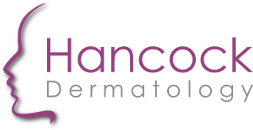Pediatric Dermatology
Our dermatologist at Hancock Dermatology uses the latest technology to diagnose and treat skin conditions in persons younger than 18 years. She also performs dermatological procedures when indicated and offers parents advice on how to take better care of their childrens’ skin. Dr. Sanford is a member of the Society for Pediatric Dermatology and has been published in the Journal of Pediatric Dermatology.
Our board certified dermatologist also specializes in the treatment of newborns, infants, children, and adolescents. She treats both common and rare pediatric diseases that affect the skin, hair and nails.
Our physician is committed to providing the highest standard of care. During your child’s visit, the medical staff will take a comprehensive personal and family history. Next, Dr. Sanford will do a thorough physical examination and order any required tests to help her arrive at the correct diagnosis. Finally, any needed treatments will be prescribed or explained and follow-up will be arranged.
Pediatric Dermatological Conditions Treated
- Acne
- Angiofibromas
- Atopic dermatitis or eczema
- Autoimmune diseases that affect children like vitiligo, lupus and scleroderma
- Benign growths that develop on children like cysts and lipomas
- Birth defects that affect the skin like hemangiomas, port wine stains and other vascular abnormalities
- Birth marks which are pigmented like Mongolian spots and café-au-lait spots
- Bullous diseases or blistering diseases which affect children like linear immunoglobulin A dermatosis
- Chickenpox
- Connective tissue diseases that affect children like morphea and dermatomyositis
- Contact dermatitis or skin allergies like poison ivy and poison oak
- Diaper rash
- Drug reactions
- Dry skin
- Genetic skin diseases which are passed down from one generation to another and include tuberous sclerosis, neurofibromatosis, ichthyosis and epidermolysis bullosa
- Herpes simplex or cold sores
- Hyperhidrosis or excessive sweating
- Impetigo
- Insect bites
- Keratosis pilaris
- Mastocytosis (urticaria pigmentosa)
- Moles
- Molluscum contagiosum
- Nevus sebaceous
- Newborn rashes
- Pilomatricomas
- Poison ivy
- Psoriasis
- Pyogenic granulomas
- Rashes
- Ringworms
- Scabies
- Scars like keloid scars
- Seborrheic dermatitis
- Skin infections caused by bacteria, viruses and fungi
- Sun sensitive skin conditions
- Urticaria or hives
- Ulcers
- Warts
- Alopecia or hair loss conditions caused by various factors like autoimmunity (alopecia areata), tight hairstyles (traction alopecia), hair products (chemical alopecia), infections (tinea capitis) and stress (telogen effluvium).
- Cradle cap
- Dandruff
- Scalp conditions like psoriasis, seborrheic dermatitis, lice, warts, itchy scalps and folliculitis
- Excessive hair growth which is also known as hirsutism or hypertrichosis
- Fungal infections (onychomycosis)
- Other dermatological conditions that cause discolored, thickened or disfigured nails like psoriasis, eczema, alopecia areata and ingrown nails
- Skin biopsies. This minimal procedure involves the doctor numbing the area and removing a small sample of the skin, hair or nail to send it to the laboratory to be evaluated.
- Surgical removal of benign or non-cancerous growths that develop on the skin in children. This includes birth marks, moles, skin tags, warts, cysts (fluid filled swellings), lipomas (fat collections), fibromas (fibrous tissue collections) and pyogenic granulomas.
- Medical therapy for skin lesions: This includes topical therapy or the in office application of medications to skin lesions. Our doctor also prescribes systemic therapy for skin conditions including both oral and injectable medication.
- Coming soon: Laser treatment for vascular birthmarks like hemangiomas and port wine stains. Laser treatment for spider angiomas and telangiectasia or dilated capillaries can also be done.
- Medical photography: Clinical photographs to document skin conditions in patients. This is done to aid making the correct diagnosis and to monitor the patient’s progress as they receive treatment.
Request an Appointment!
Pediatric Dermatological Advice
In addition to offering testing services and treatment protocols, our dermatologist is also a great resources for parents who want to know how to prevent skin conditions that affect infants, adolescents and all the age groups in between them.
Dr. Sanford advises using unscented lotions and creams for children since many fragrances are irritating to babies’ skin and can increase their risk of developing rashes. She also recommends avoiding the use of harsh soaps or cleansers on children since they strip the natural oils from the skin and make children’s skin very dry.
Dr Sanford advises teenagers with acne not to wash their face more than twice a day. They Should use warm water and a mild soap which has been specially formulated for acne. Benozyl Peroxide wash is an effective over the counter acne wash that can be used once daily, but should be rinsed carefully as it can cause bleaching of clothing and linens. Rough scrubs or rubbing with a washcloth can increase irritation.
Teens with acne who wear makeup should buy brands that are labelled “non-comedogenic” or “non-acnegenic”. This means that they do not clog pores and cause acne. In addition, they should remove it before going to sleep and make a point of throwing away old makeup.
Our dermatologists can also advice teens with acne-prone skin not to pop their pimples since this pushes the infected material deeper into the skin. Picking can also lead to more swelling, redness and scarring. This should be combined with not touching the face unnecessarily as it can spread bacteria and increase the inflammation. Mobile phones, glasses and sports equiptment should also be cleaned frequently with antiseptic wipes for the same reason.
Teens can also be told to shampoo their hair frequently and style it out of their face to prevent oils from the hair clogging pores on the forehead. Teenagers who get body acne should be advised not to wear tight clothes which do not allow the skin to breathe as it can increase irritation. They can also be reminded to shower after engaging in games and other activities that result in sweating.
